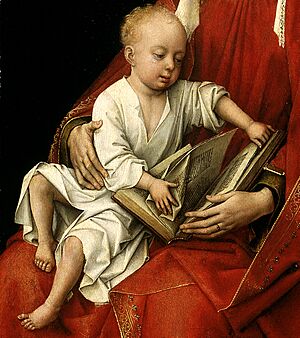Durán Madonna facts for kids

The Durán Madonna is a famous painting by the Netherlandish painter Rogier van der Weyden. He finished this oil painting on wood between 1435 and 1438. It is also known as the Madonna in Red or Virgin and Child in a Niche.
The painting shows the Virgin Mary sitting calmly in a long, red robe. She holds the child Jesus on her lap. Jesus is looking through a holy book. Both Mary and Jesus are looking at the book.
Van der Weyden placed Mary and Jesus inside a niche or archway. This makes them look like statues. This painting was inspired by Jan van Eyck's Ince Hall Madonna. Many artists later copied the Durán Madonna.
In this painting, Jesus looks older than in many other paintings from that time. He is shown as a small child, not a baby. The painting has a strong, sculptural look. This was a style van der Weyden often used. The colours are similar to his other works, like Descent from the Cross (around 1435).
A collector named Pedro Fernández-Durán bought the painting in 1899. He gave it to the Museo del Prado in 1930, where it is today.
What Does the Painting Show?
Mary wears a long, red robe with a hood and a white head covering. The child Jesus sits on her lap in a white shirt. He is curiously turning the pages of a book on his mother's knee.
The book is right in the middle of the painting. It stands for the importance of God's word in Christian belief. The museum says the book hints at "Holy Scriptures that announce Christ's redemptive mission."
An angel in a dark grey dress floats above Mary's head. The angel holds a crown decorated with pearls. This crown is for Mary when she becomes the Queen of Heaven. Mary's long robe flows around her, hiding her throne. It falls to the support under her feet.
Mary and Jesus are framed by a carved niche or archway. It has tracery (stone patterns) like those in van der Weyden's Descent from the Cross. The curved lines of the niche match Mary's figure as she leans over Jesus. These curves and warm colours make the painting feel balanced and peaceful.
Some art experts in the past did not focus much on how old Jesus looks. They also did not focus on the book or how Jesus turns its pages. More recently, experts like Alfred Acres have looked closer at Jesus's free movement. They also studied his realistic look in such an elegant painting.
Acres believes the book is very important to understanding the painting. He notes it is perfectly in the center. Both Mary and Jesus look at it and touch it. Jesus seems to be turning the pages backwards, towards the beginning.
If the book is facing Mary, Jesus is turning pages from the end to the start. Holy books were often in paintings of the Virgin Mary in the 1400s. They usually showed Mary as a symbol of learning. But in no other painting does a child turn pages with such energy. Acres thinks Jesus is turning back to Genesis: 3. This part of the Bible describes the Fall of Man. This suggests the painting is about saving humanity.
Art historian Lorne Campbell thinks the painting was influenced by Robert Campin's Virgin and Child. This includes the idea of female beauty and the elegant way the long clothes are folded. Campbell points out that both paintings use strong diagonal lines. The main figures are pushed forward, almost like a trompe-l'œil (trick of the eye).
The Durán Madonna is often compared to van der Weyden's Miraflores Altarpiece. This is because of the colours of Mary's dress and the sculptural look. The drawing of Mary's head is also very similar to the Madonna in his Froimont Diptych (after 1460).
Because of these strong similarities, experts are sure van der Weyden painted it. However, the painting was copied many times in Spain after it moved there in the 1500s.
The black paint behind Mary was likely added later, perhaps in the 1700s. This might have been to make the painting seem less religious. X-rays have not found any hidden details under the black paint.
Clever Tricks in the Painting
Van der Weyden often painted figures that looked very real and full of life. He placed them in small, shallow spaces. This made them seem cramped and larger than they really were. The space around Mary and Jesus is unclear.
Mary and Jesus stand on a projecting corbel (a support sticking out from a wall). This makes it seem like they are part of a relief sculpture in a much bigger artwork. This gives the painting a confusing but unique sense of space.
This painting is an early example of van der Weyden making his figures look like polychrome (multi-coloured) sculptures. The plain background makes this effect even stronger. Van der Weyden often blurred the line between sculpture and painting. You can see this clearly in his Descent from the Cross.
Art historian Robert Nosow notes how the Gothic frame looks like architecture. He also points out how Mary and Jesus seem like statues that have come to life. Shirley Neilsen Blum, another art historian, writes that these fake sculptural parts "force the viewer to continually confront the seemingly real presence of two media, sculpture and painting." She adds that Rogier "defies logic and therefore enhances the magical quality of the image. Divinity is stressed because it has transcended media definition."
See also
 In Spanish: Madonna Durán para niños
In Spanish: Madonna Durán para niños
- List of works by Rogier van der Weyden



